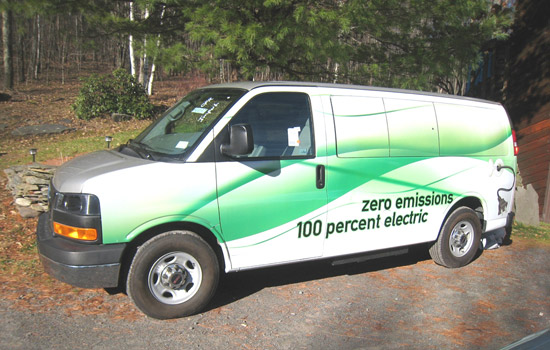Student Engineers Begin Work with Facilities Team to Restore Damaged Electronic-Van
Vehicle becomes a teaching tool and could eventually become campus transportation
Students from RIT’s IEEE chapter and engineers from Facilities Management are restoring an e-vehicle donated by Electric Vehicle Corp.
Electrical engineering students at Rochester Institute of Technology saw only potential when given the opportunity to restore an inoperable electronic van with no owner’s manual.
Electric Vehicle Corp. donated the van to RIT and the university’s Institute of Electrical and Electronics Engineers student chapter this past summer. The corporation had purchased a 2012 GMC Sahara, 8-passenger van, and shipped it to a company in England to be retrofitted from a standard engine to an electronic-vehicle. On the return trip, it was damaged.
Rather than disposing of the vehicle, EVC sought university engineering programs to take on the restoration as a potential student design project. RIT took the wheel—and the van—with enthusiastic “drivers” from the IEEE student chapter and RIT’s Facilities Management Services team steering this project.
“When we got the van, we had no information on it, there were no schematics, diagrams or instructions,” says Jason Andrews, president of the IEEE student chapter based in RIT’s Kate Gleason College of Engineering.
Despite the challenges, the students persisted.
“The first thing we did was evaluate the microelectronics and charged the van. At that point it was running, and we drove around the block,” says Andrews, a third-year student from Reading, Pa. “The next issue was the battery. It was draining rapidly. We are looking at what might be drawing that current away from the system.”
Andrews and the project team will meet with Electric Vehicle Corp. representatives to discuss the project status and how to assess the battery system from 1 to 2 p.m. Oct. 11, at Facilities Management Services.
Lithium ion batteries are not standard in vehicles—yet. Lighter than traditional lead-acid batteries and capable of higher energy storage, lithium ion batteries have been used primarily in consumer electronics, with growing trends for the batteries in automotive, aeronautics and military applications.
Once initial testing is complete and some repairs have been made, the van could be capable of going 50 to 75 miles per hour, and approximately 100 miles on a single charge. Andrews and the IEEE students are thinking well beyond this first stage of the project as it provides an opportunity to involve more than electrical engineering students.
Alex Synesael, a second-year electrical engineering major from Newark, N.Y., agreed: “It’s beyond just getting the van working. I think it will be interesting to bring in programs you wouldn’t ordinarily expect to work on a project like this, maybe business, marketing, computer science students. It can really make this project something popular on campus. It’s a great tool for us as a club, and a great opportunity to bring the university and various clubs together.”













